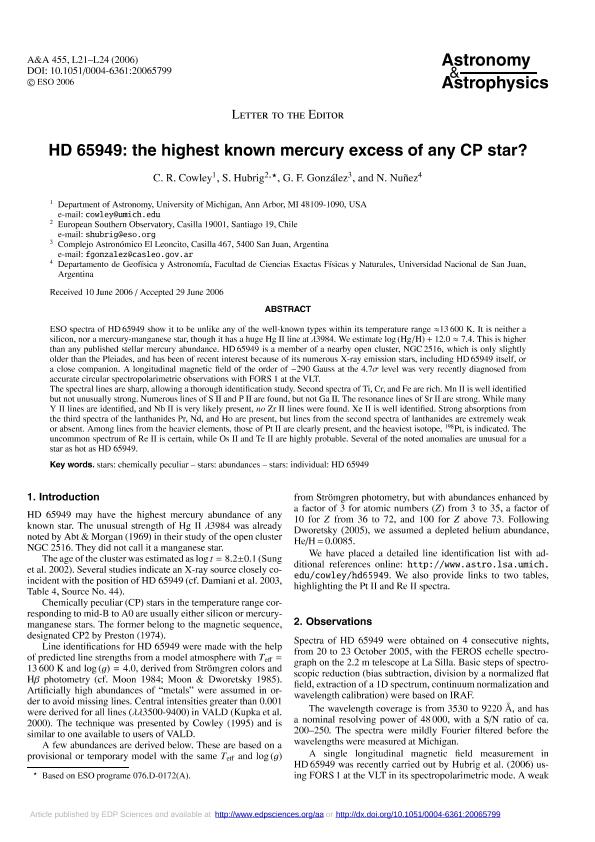Artículo
HD 65949: The highest known mercury excess of any CP star?
Fecha de publicación:
12/2006
Editorial:
EDP Sciences
Revista:
Astronomy and Astrophysics
ISSN:
0004-6361
Idioma:
Inglés
Tipo de recurso:
Artículo publicado
Clasificación temática:
Resumen
ESO spectra of HD 65949 show it to be unlike any of the well-known types within its temperature range ~13600 K. It is neither a silicon, nor a mercury-manganese star, though it has a huge Hg II line at 3984A. We estimate log (Hg/H) + 12.0 ~ 7.4. This is higher than any published stellar mercury abundance. HD 65949 is a member of a nearby open cluster, NGC 2516, which is only slightly older than the Pleiades, and has been of recent interest because of its numerous X-ray emission stars, including HD 65949 itself, or a close companion. A longitudinal magnetic field of the order of -290 Gauss at the 4.7 sigma level was very recently diagnosed from accurate circular spectropolarimetric observations with FORS 1 at the VLT. The spectral lines are sharp, allowing a thorough identification study. Second spectra of Ti, Cr, and Fe are rich. Mn II is well identified but not unusually strong. Numerous lines of S II and P II are found, but not Ga II. The resonance lines of Sr II are strong. While many Y II lines are identified, and Nb II is very likely present, no Zr II lines were found. Xe II is well identified. Strong absorptions from the third spectra of the lanthanides Pr, Nd, and Ho are present, but lines from the second spectra of lanthanides are extremely weak or absent. Among lines from the heavier elements, those of Pt II are clearly present, and the heaviest isotope, 198Pt, is indicated. The uncommon spectrum of Re II is certain, while Os II and Te II are highly probable. Several of the noted anomalies are unusual for a star as hot as HD 65949.
Palabras clave:
CHEMICALLY
,
PECULIAR
,
ABUNDANCES
,
HD65949
Archivos asociados
Licencia
Identificadores
Colecciones
Articulos(ICATE)
Articulos de INST.D/CS ASTRONOMICAS D/LA TIERRA Y DEL ESPACIO
Articulos de INST.D/CS ASTRONOMICAS D/LA TIERRA Y DEL ESPACIO
Citación
Cowley, C. R; Hubrig, S.; Gonzalez, Jorge Federico; Nuñez, Natalia Edith; HD 65949: The highest known mercury excess of any CP star?; EDP Sciences; Astronomy and Astrophysics; 455; 2; 12-2006; 21-24
Compartir
Altmétricas




